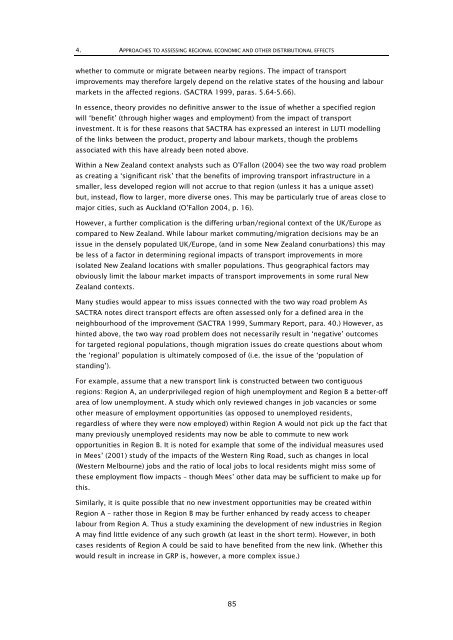Research 350 - NZ Transport Agency
Research 350 - NZ Transport Agency
Research 350 - NZ Transport Agency
Create successful ePaper yourself
Turn your PDF publications into a flip-book with our unique Google optimized e-Paper software.
4. APPROACHES TO ASSESSING REGIONAL ECONOMIC AND OTHER DISTRIBUTIONAL EFFECTS<br />
whether to commute or migrate between nearby regions. The impact of transport<br />
improvements may therefore largely depend on the relative states of the housing and labour<br />
markets in the affected regions. (SACTRA 1999, paras. 5.64-5.66).<br />
In essence, theory provides no definitive answer to the issue of whether a specified region<br />
will ‘benefit’ (through higher wages and employment) from the impact of transport<br />
investment. It is for these reasons that SACTRA has expressed an interest in LUTI modelling<br />
of the links between the product, property and labour markets, though the problems<br />
associated with this have already been noted above.<br />
Within a New Zealand context analysts such as O’Fallon (2004) see the two way road problem<br />
as creating a ‘significant risk’ that the benefits of improving transport infrastructure in a<br />
smaller, less developed region will not accrue to that region (unless it has a unique asset)<br />
but, instead, flow to larger, more diverse ones. This may be particularly true of areas close to<br />
major cities, such as Auckland (O’Fallon 2004, p. 16).<br />
However, a further complication is the differing urban/regional context of the UK/Europe as<br />
compared to New Zealand. While labour market commuting/migration decisions may be an<br />
issue in the densely populated UK/Europe, (and in some New Zealand conurbations) this may<br />
be less of a factor in determining regional impacts of transport improvements in more<br />
isolated New Zealand locations with smaller populations. Thus geographical factors may<br />
obviously limit the labour market impacts of transport improvements in some rural New<br />
Zealand contexts.<br />
Many studies would appear to miss issues connected with the two way road problem As<br />
SACTRA notes direct transport effects are often assessed only for a defined area in the<br />
neighbourhood of the improvement (SACTRA 1999, Summary Report, para. 40.) However, as<br />
hinted above, the two way road problem does not necessarily result in ‘negative’ outcomes<br />
for targeted regional populations, though migration issues do create questions about whom<br />
the ‘regional’ population is ultimately composed of (i.e. the issue of the ‘population of<br />
standing’).<br />
For example, assume that a new transport link is constructed between two contiguous<br />
regions: Region A, an underprivileged region of high unemployment and Region B a better-off<br />
area of low unemployment. A study which only reviewed changes in job vacancies or some<br />
other measure of employment opportunities (as opposed to unemployed residents,<br />
regardless of where they were now employed) within Region A would not pick up the fact that<br />
many previously unemployed residents may now be able to commute to new work<br />
opportunities in Region B. It is noted for example that some of the individual measures used<br />
in Mees’ (2001) study of the impacts of the Western Ring Road, such as changes in local<br />
(Western Melbourne) jobs and the ratio of local jobs to local residents might miss some of<br />
these employment flow impacts – though Mees’ other data may be sufficient to make up for<br />
this.<br />
Similarly, it is quite possible that no new investment opportunities may be created within<br />
Region A – rather those in Region B may be further enhanced by ready access to cheaper<br />
labour from Region A. Thus a study examining the development of new industries in Region<br />
A may find little evidence of any such growth (at least in the short term). However, in both<br />
cases residents of Region A could be said to have benefited from the new link. (Whether this<br />
would result in increase in GRP is, however, a more complex issue.)<br />
85
















